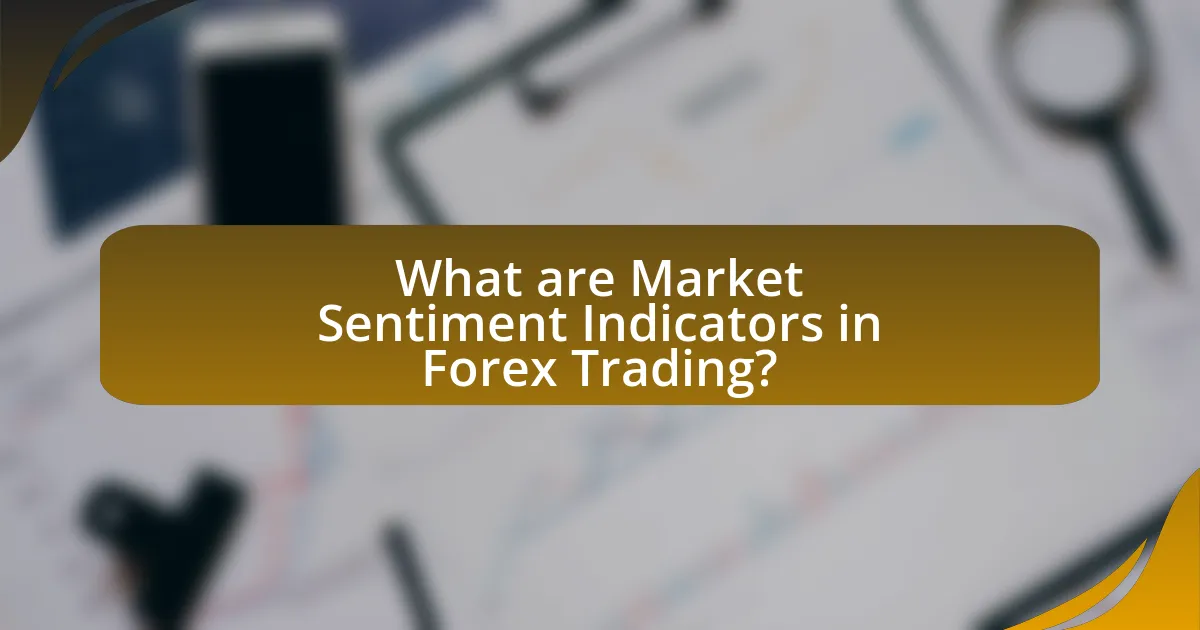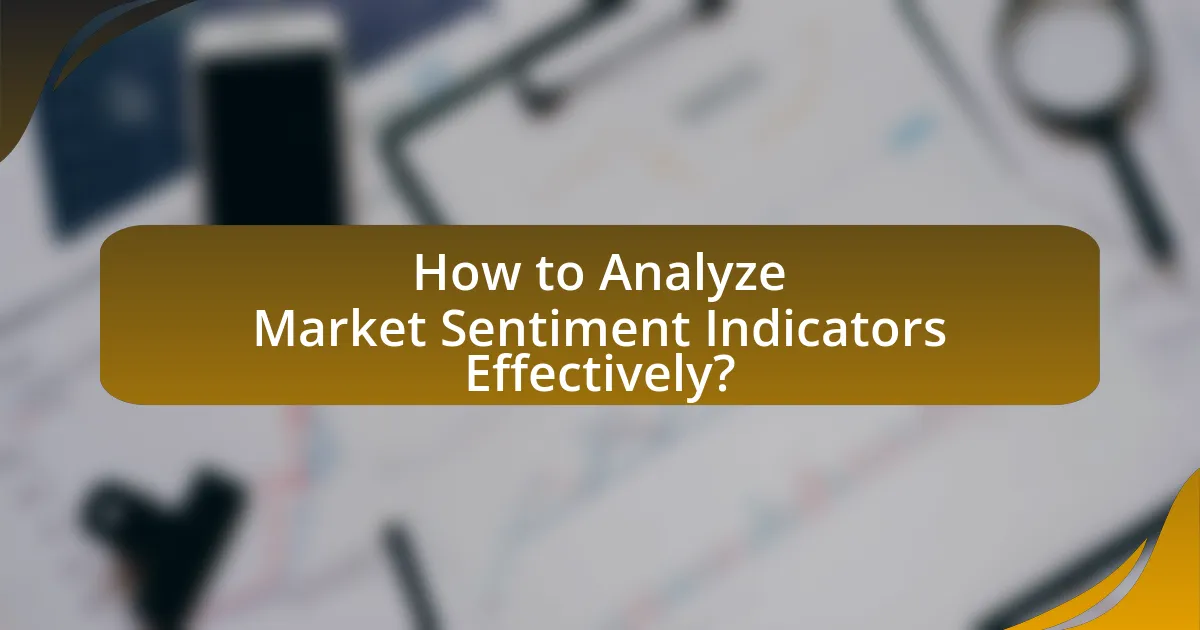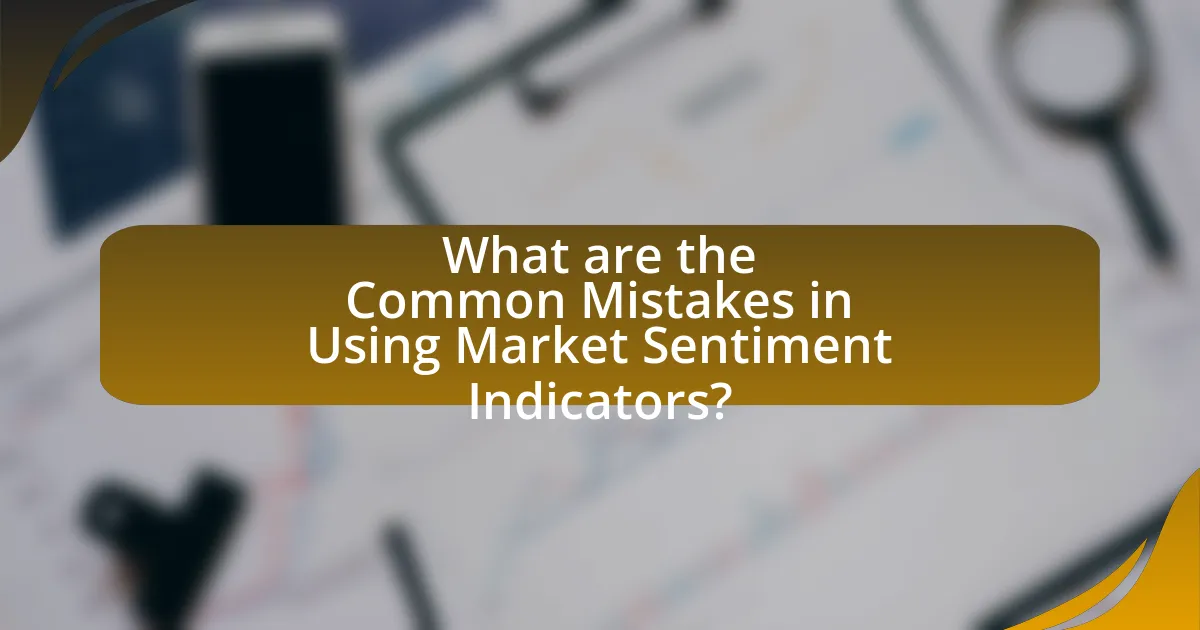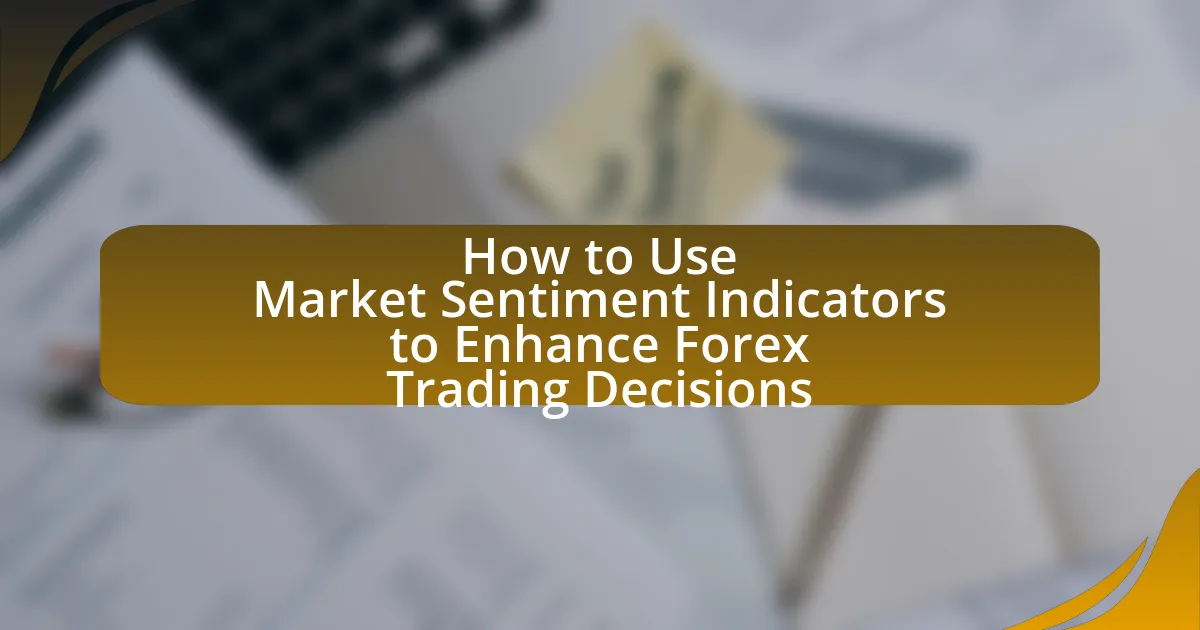Market sentiment indicators are essential tools in Forex trading that assess the overall attitude of traders towards specific currency pairs. This article explores the significance of these indicators, including the Commitment of Traders report and the Fear and Greed Index, in influencing trading decisions and predicting market movements. It discusses how traders interpret sentiment data, the psychological factors at play, and the best practices for integrating sentiment analysis with technical strategies. Additionally, it highlights common mistakes to avoid and strategies to enhance the effectiveness of sentiment indicators in making informed trading decisions.

What are Market Sentiment Indicators in Forex Trading?
Market sentiment indicators in Forex trading are tools that gauge the overall attitude of traders towards a particular currency pair. These indicators analyze data such as trader positioning, market trends, and news sentiment to determine whether the market is bullish or bearish. For instance, the Commitment of Traders (COT) report provides insights into the positions held by different types of traders, revealing whether the majority are long or short on a currency. This information can help traders make informed decisions by understanding the prevailing market sentiment, which often influences price movements.
How do Market Sentiment Indicators influence trading decisions?
Market sentiment indicators significantly influence trading decisions by providing insights into the overall mood of market participants. Traders utilize these indicators, such as the Fear and Greed Index or the Commitment of Traders report, to gauge whether the market is overly bullish or bearish. For instance, when sentiment indicators show extreme greed, it may signal an overbought market, prompting traders to consider selling or shorting positions. Conversely, when indicators reflect extreme fear, it may indicate an oversold market, encouraging traders to buy. Historical data supports this, as studies have shown that sentiment often precedes price movements, making it a valuable tool for anticipating market trends and making informed trading decisions.
What types of Market Sentiment Indicators are commonly used?
Commonly used market sentiment indicators include the Commitment of Traders (COT) report, the Fear and Greed Index, and various sentiment surveys such as the American Association of Individual Investors (AAII) Sentiment Survey. The COT report provides insights into the positions of different types of traders, indicating whether they are bullish or bearish. The Fear and Greed Index measures market emotions based on volatility, market momentum, and other factors, reflecting overall investor sentiment. Sentiment surveys, like the AAII survey, gauge individual investor sentiment, offering a snapshot of market psychology. These indicators are widely recognized for their ability to inform trading decisions by highlighting prevailing market attitudes.
How do traders interpret Market Sentiment Indicators?
Traders interpret Market Sentiment Indicators as tools that reflect the overall mood of market participants, indicating whether they are predominantly bullish or bearish. These indicators, such as the Commitment of Traders report or the Fear and Greed Index, provide insights into the positioning of traders and can signal potential market reversals or continuations. For instance, a high level of bullish sentiment may suggest overbought conditions, while extreme bearish sentiment could indicate oversold conditions. Historical data shows that when sentiment indicators reach extreme levels, they often precede price corrections, reinforcing their value in decision-making processes.
Why is understanding Market Sentiment important for Forex traders?
Understanding market sentiment is crucial for Forex traders because it influences price movements and trading decisions. Market sentiment reflects the overall attitude of investors toward a particular currency pair, which can lead to trends and reversals. For instance, when traders are optimistic about a currency, demand increases, driving up its value; conversely, pessimism can lead to a decline. Historical data shows that sentiment indicators, such as the Commitment of Traders report, can predict market movements with a degree of accuracy, highlighting the importance of sentiment analysis in making informed trading decisions.
How can Market Sentiment Indicators predict market movements?
Market sentiment indicators predict market movements by analyzing the collective attitudes and emotions of traders towards a particular asset or market. These indicators, such as the Fear and Greed Index or the Commitment of Traders report, reflect the prevailing mood in the market, which can influence buying and selling decisions. For instance, when sentiment indicators show extreme fear, it often signals that the market may be oversold, leading to potential price reversals. Conversely, high levels of greed may indicate overbought conditions, suggesting a possible market correction. Historical data supports this, as studies have shown that sentiment shifts often precede significant price changes, making these indicators valuable tools for forecasting market trends.
What role does psychology play in Market Sentiment?
Psychology significantly influences market sentiment by shaping traders’ perceptions and behaviors. Emotional factors such as fear, greed, and optimism can lead to collective decision-making that drives market trends. For instance, during periods of market volatility, fear can cause panic selling, while excessive optimism can lead to asset bubbles. Research indicates that behavioral finance principles, such as herd behavior and loss aversion, directly impact trading patterns and market movements. These psychological elements create fluctuations in market sentiment, which traders can analyze to make informed Forex trading decisions.

How to Analyze Market Sentiment Indicators Effectively?
To analyze market sentiment indicators effectively, traders should focus on understanding the underlying data and trends that these indicators represent. This involves examining metrics such as the Commitment of Traders (COT) report, which provides insights into the positions of different market participants, and sentiment surveys that gauge trader attitudes. For instance, the COT report reveals the positioning of commercial and non-commercial traders, allowing traders to identify potential market reversals when extreme sentiment is observed. Additionally, utilizing tools like the Fear and Greed Index can help traders assess overall market sentiment, indicating whether the market is overly bullish or bearish. Historical data shows that when sentiment indicators reach extreme levels, they often precede price corrections, thus validating their effectiveness in trading decisions.
What tools and platforms can be used to track Market Sentiment?
Tools and platforms that can be used to track market sentiment include social media analytics tools, sentiment analysis software, and financial news aggregators. Social media analytics tools like Brandwatch and Hootsuite analyze public sentiment by monitoring social media conversations. Sentiment analysis software such as Lexalytics and MonkeyLearn processes large volumes of text data to gauge market sentiment based on user-generated content. Financial news aggregators like Bloomberg and Reuters provide real-time news updates and sentiment indicators derived from market reports and expert analyses. These tools collectively offer insights into market trends and trader sentiment, which are crucial for making informed forex trading decisions.
How do different platforms compare in terms of Market Sentiment analysis?
Different platforms for Market Sentiment analysis vary significantly in their methodologies and data sources. For instance, platforms like Bloomberg and Reuters utilize proprietary algorithms and extensive financial databases to provide real-time sentiment analysis, often incorporating news sentiment and social media trends. In contrast, platforms such as TradingView and MetaTrader rely more on user-generated content and community sentiment indicators, which can lead to a more subjective interpretation of market trends. Research indicates that platforms employing advanced machine learning techniques, like Sentifi, can achieve higher accuracy in sentiment predictions by analyzing vast amounts of unstructured data, including social media and news articles. This comparative analysis highlights that the choice of platform can greatly influence the effectiveness of sentiment analysis in Forex trading decisions.
What features should traders look for in Market Sentiment tools?
Traders should look for real-time data, user sentiment analysis, and historical sentiment trends in Market Sentiment tools. Real-time data allows traders to make timely decisions based on current market conditions, while user sentiment analysis provides insights into the collective behavior of market participants, indicating potential price movements. Historical sentiment trends help traders understand past market behaviors and patterns, enhancing predictive capabilities. These features collectively enable traders to gauge market psychology effectively, leading to more informed trading decisions.
How can traders combine Market Sentiment with technical analysis?
Traders can combine market sentiment with technical analysis by using sentiment indicators alongside chart patterns and price action. For instance, traders can analyze sentiment data from sources like the Commitment of Traders report, which shows the positioning of different market participants, and then apply technical analysis tools such as moving averages or support and resistance levels to identify potential entry and exit points. This approach allows traders to validate their technical signals with the prevailing market sentiment, enhancing the likelihood of successful trades. Research has shown that integrating sentiment analysis with technical indicators can improve trading performance, as it provides a more comprehensive view of market dynamics.
What are the best practices for integrating Market Sentiment into trading strategies?
The best practices for integrating Market Sentiment into trading strategies include utilizing sentiment analysis tools, monitoring social media and news sentiment, and combining sentiment data with technical indicators. Sentiment analysis tools, such as the Fear and Greed Index, provide insights into market psychology, allowing traders to gauge whether the market is overly bullish or bearish. Monitoring social media platforms and news outlets helps traders capture real-time sentiment shifts, which can precede price movements. Additionally, combining sentiment data with technical indicators, like moving averages or RSI, enhances decision-making by confirming trends or reversals, thereby increasing the likelihood of successful trades. These practices are supported by studies indicating that sentiment analysis can improve trading performance by aligning trades with prevailing market emotions.
How does Market Sentiment complement other forms of analysis?
Market sentiment complements other forms of analysis by providing insights into the collective emotions and behaviors of traders, which can influence price movements. While technical analysis focuses on historical price patterns and indicators, and fundamental analysis examines economic factors, market sentiment captures the prevailing mood of the market, often revealing potential reversals or continuations in trends. For instance, during periods of extreme bullish sentiment, prices may rise rapidly, but this can also indicate an overbought condition, suggesting a possible correction. Conversely, extreme bearish sentiment may signal undervaluation, presenting buying opportunities. Research has shown that incorporating sentiment analysis can improve predictive accuracy in trading strategies, as evidenced by studies indicating that sentiment indicators can lead to better timing in entry and exit points in the Forex market.

What are the Common Mistakes in Using Market Sentiment Indicators?
Common mistakes in using market sentiment indicators include over-reliance on these indicators without considering other market factors, misinterpreting the data due to lack of context, and failing to account for market volatility. Traders often assume that high sentiment indicates a strong market direction, neglecting to analyze underlying fundamentals. Additionally, many overlook the importance of timing; sentiment can shift rapidly, leading to poor decision-making if traders act on outdated information. Research shows that sentiment indicators can be misleading during extreme market conditions, where they may not accurately reflect future price movements.
What pitfalls should traders avoid when interpreting Market Sentiment?
Traders should avoid over-reliance on market sentiment indicators without considering other fundamental and technical factors. Solely focusing on sentiment can lead to misinterpretations, as market sentiment can be influenced by transient news events or social media trends that do not reflect underlying economic conditions. For instance, during the 2008 financial crisis, many traders misjudged market sentiment, leading to significant losses because they ignored critical economic indicators like unemployment rates and housing market data. Therefore, integrating sentiment analysis with comprehensive market research is essential for informed trading decisions.
How can over-reliance on Market Sentiment lead to poor trading decisions?
Over-reliance on market sentiment can lead to poor trading decisions by causing traders to act on emotional reactions rather than objective analysis. When traders prioritize sentiment indicators, they may ignore fundamental data or technical analysis, resulting in impulsive trades based on fear or greed. For instance, during market euphoria, traders might buy into overvalued assets, while in panic, they may sell undervalued assets, leading to significant losses. Historical data shows that sentiment-driven trading often results in higher volatility and increased risk, as evidenced by the 2008 financial crisis, where emotional trading contributed to market instability.
What are the signs of misinterpreting Market Sentiment data?
Signs of misinterpreting Market Sentiment data include overreliance on anecdotal evidence, ignoring quantitative metrics, and failing to consider the broader economic context. Overreliance on anecdotal evidence can lead traders to make decisions based on personal opinions rather than statistical data, which may not accurately reflect market trends. Ignoring quantitative metrics, such as the Commitment of Traders report, can result in a skewed understanding of market positions. Additionally, failing to consider the broader economic context, such as geopolitical events or economic indicators, can lead to misguided interpretations of sentiment data. These signs indicate a lack of comprehensive analysis, which can ultimately result in poor trading decisions.
How can traders improve their use of Market Sentiment Indicators?
Traders can improve their use of Market Sentiment Indicators by integrating multiple indicators to gain a comprehensive view of market psychology. Utilizing tools such as the Commitment of Traders (COT) report, which provides insights into the positions of different market participants, allows traders to identify potential market reversals. Additionally, combining sentiment indicators with technical analysis can enhance decision-making; for instance, when sentiment is overly bullish or bearish, it may signal an impending price correction. Historical data shows that traders who align sentiment indicators with price action have a higher success rate, as evidenced by studies indicating that sentiment extremes often precede market reversals.
What strategies can enhance the effectiveness of Market Sentiment analysis?
To enhance the effectiveness of Market Sentiment analysis, employing a multi-faceted approach that includes data triangulation, sentiment scoring, and real-time monitoring is essential. Data triangulation involves integrating various data sources, such as social media sentiment, news articles, and market reports, to create a comprehensive view of market sentiment. Sentiment scoring quantifies qualitative data, allowing traders to assess the strength of sentiment trends quantitatively. Real-time monitoring ensures that traders can react promptly to shifts in sentiment, which is crucial in the fast-paced Forex market. Studies have shown that traders who utilize these strategies can improve their decision-making accuracy, as evidenced by a 2019 report from the Journal of Financial Markets, which indicated that sentiment analysis significantly correlates with market movements.
How can continuous learning and adaptation improve trading outcomes?
Continuous learning and adaptation can significantly improve trading outcomes by enabling traders to refine their strategies based on real-time market data and evolving trends. By consistently analyzing market sentiment indicators, traders can identify shifts in investor behavior and adjust their positions accordingly. For instance, a study by the CFA Institute found that traders who actively engage in learning and adapt their strategies based on market feedback achieve higher returns compared to those who do not. This adaptability allows traders to mitigate risks and capitalize on emerging opportunities, ultimately leading to more informed and profitable trading decisions.
What are the best practices for utilizing Market Sentiment Indicators in Forex trading?
The best practices for utilizing Market Sentiment Indicators in Forex trading include analyzing the sentiment data in conjunction with technical analysis, using sentiment indicators to confirm trading signals, and monitoring changes in sentiment to anticipate market reversals. Analyzing sentiment data alongside technical indicators, such as moving averages or support and resistance levels, enhances decision-making by providing a broader market context. For instance, if sentiment is overwhelmingly bullish while technical indicators show overbought conditions, traders may consider this a warning sign for potential price corrections. Additionally, using sentiment indicators like the Commitment of Traders (COT) report can help traders identify market positioning and potential reversals, as extreme sentiment often precedes market corrections. Monitoring sentiment shifts, such as sudden changes in trader positioning, can also provide early warnings of trend reversals, allowing traders to adjust their strategies accordingly.
